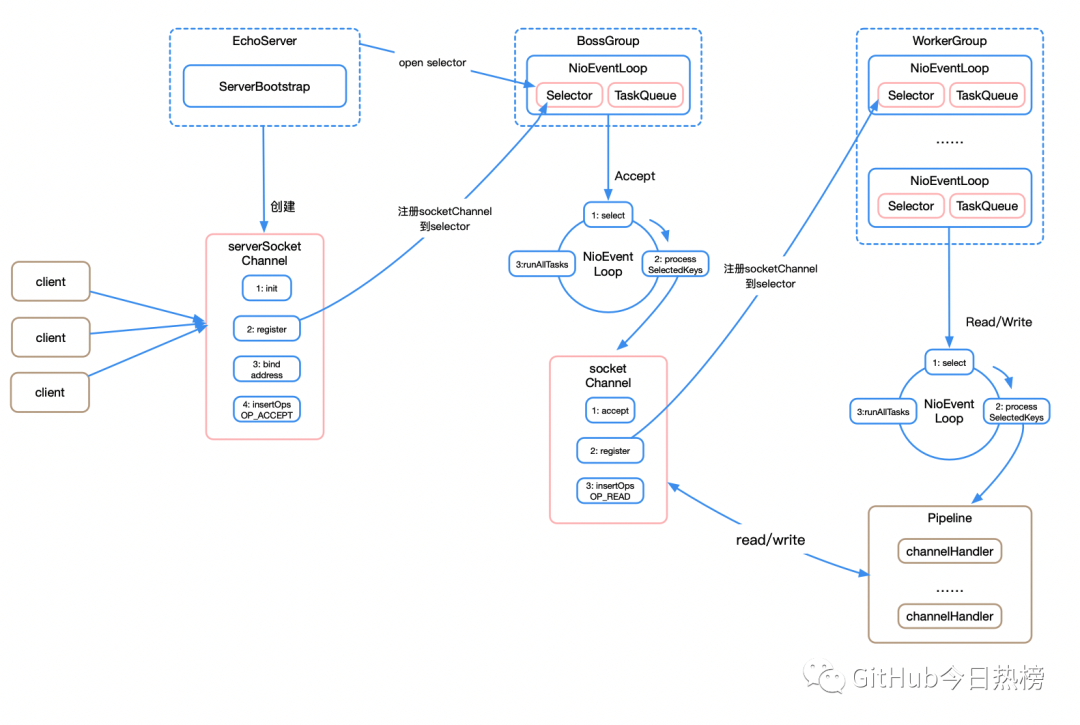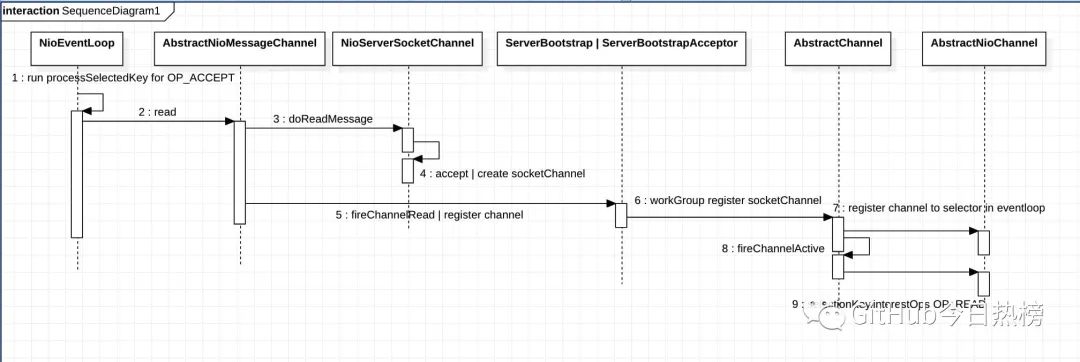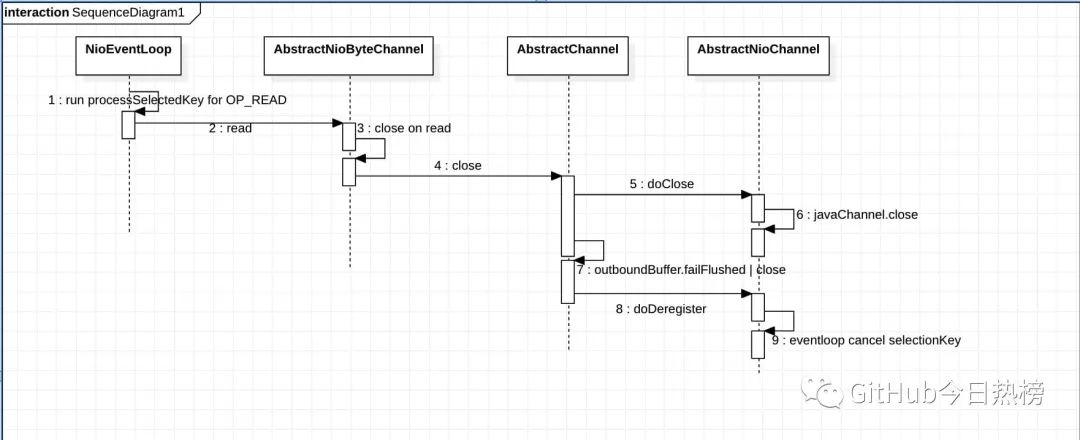一文了解 Netty 整体流程

本文基于版本 4.1.46,同时只描述类而不展示具体源码。
Netty 的整体流程
Netty 的整体流程相对来说还是比较复杂的,初学者往往会被绕晕。所以这里总结了一下整体的流程,从而对 Netty
的整体服务流程有一个大致的了解。从功能上,流程可以分为服务启动、建立连接、读取数据、业务处理、发送数据、关闭连接以及关闭服务。整体流程如下所示(图中没有包含关闭的部分):

服务启动
服务启动时,我们以 example 代码中的 EchoServer 为例,启动的过程以及相应的源码类如下:
创建 selector:
EchoServer#new NioEventLoopGroup(1)->NioEventLoop#provider.openSelector() :EchoServer#b.bind(PORT).sync->AbstractBootStrap#doBind()->initAndRegister()-> channelFactory.newChannel() / init(channel)EchoServer#b.bind(PORT).sync->AbstractBootStrap#doBind()->initAndRegister()-> config().group().register(channel)EchoServer#b.bind(PORT).sync->AbstractBootStrap#doBind()->initAndRegister()->config().group().register(channel)->AbstractChannel#register0(promise)->AbstractNioChannel#javaChannel().register(eventLoop().unwrappedSelector(), 0, this) : 将 server socket channelEchoServer#b.bind(PORT).sync()->AbstractBootStrap#doBind()->doBind0()->AbstractChannel#doBind(localAddress)->NioServerSocketChannel#javaChannel().bind(localAddress, config.getBacklog())注册 OP_READ 事件:
EchoServer#b.bind(PORT).sync()->AbstractBootStrap#doBind()->doBind0()->AbstractChannel#pipeline.fireChannelActive()->AbstractNioChannel#selectionKey.interestOps(interestOps|readInterestOp)上述启动流程中,1、2、3 是由我们自己的线程执行的,即 mainThread,4、5、6 是由 Boss Thread 执行。相应时序图如下:

建立连接
服务启动后便是建立连接的过程了,相应过程及源码类如下:
NioEventLoop 中的 selector 轮询创建连接事件(OP_ACCEPT):
NioEventLoop#run()->processSelectedKey()创建 socket channel:
NioEventLoop#run()->processSelectedKey()->AbstractNioMessageChannel#read->NioServerSocketChannel#doReadMessages()->SocketUtil#accept(serverSocketChannel)从worker group 中选择一个 NioEventLoop 开始注册 socket channel:
NioEventLoop#run()->processSelectedKey()->AbstractNioMessageChannel#fireChannelRead->ServerBootstrap#ServerBootstrapAcceptor#channelRead-> childGroup.register(child)将 socket channel 注册到选择的 NioEventLoop 的 selector:
NioEventLoop#run()->processSelectedKey()->AbstractNioMessageChannel#fireChannelRead->ServerBootstrap#ServerBootstrapAcceptor#channelRead-> childGroup.register(child)->AbstractChannel#register0(promise)-> AbstractNioChannel#javaChannel().register(eventLoop().unwrappedSelector(), 0, this)注册 OP_ACCEPT 事件:
NioEventLoop#run()->processSelectedKey()->AbstractNioMessageChannel#fireChannelRead->ServerBootstrap#ServerBootstrapAcceptor#channelRead-> childGroup.register(child)->AbstractChannel#pipeline.fireChannelActive()-> AbstractNioChannel#selectionKey.interestOps(interestOps | readInterestOp)同样,上述流程中 1、2、3 的执行仍由 Boss Thread 执行,直到 4、5 由具体的 Work Thread 执行。

读写与业务处理
连接建立完毕后是具体的读写,以及业务处理逻辑。以 EchoServerHandler 为例,读取数据后会将数据传播出去供业务逻辑处理,此时的 EchoServerHandler 代表我们的业务逻辑,而它的实现也非常简单,就是直接将数据写回去。我们将这块看成一个整条,流程如下:
NioEventLoop 中的 selector 轮询创建读取事件(OP_READ):
NioEventLoop#run()->processSelectedKey()nioSocketChannel 开始读取数据:
NioEventLoop#run()->processSelectedKey()->AbstractNioByteChannel#read()NioEventLoop#run()->processSelectedKey()->AbstractNioByteChannel#read()->pipeline.fireChannelRead(byteBuf)AbstractNioByteChannel#pipeline.fireChannelRead->EchoServerHandler#channelReadEchoServerHandler#write->ChannelOutboundBuffer#addMessageEchoServerHandler#flush->ChannelOutboundBuffer#addFlushEchoServerHandler#flush->NioSocketChannel#doWrite在这个过程中读写数据都是由 Work Thread 执行的,但是业务处理可以由我们自定义的线程池来处理,并且一般我们也是这么做的,默认没有指定线程的情况下仍然由 Work Thread 代为处理。

关闭连接
服务处理完毕后,单个连接的关闭是什么样的呢?
NioEventLoop 中的 selector 轮询创建读取事件(OP_READ),这里关闭连接仍然是读取事件:
NioEventLoop#run()->processSelectedKey()当字节<0 时开始执行关闭 nioSocketChannel:
NioEventLoop#run()->processSelectedKey()->AbstractNioByteChannel#read()->closeOnRead(pipeline)关闭 socketChannel:
NioEventLoop#run()->processSelectedKey()->AbstractNioByteChannel#read()->closeOnRead(pipeline)->AbstractChannel#close->AbstractNioChannel#doClose()清理消息,不接受新信息,fail 掉所有 queue 中消息:
NioEventLoop#run()->processSelectedKey()->AbstractNioByteChannel#read()->closeOnRead(pipeline)->AbstractChannel#close->outboundBuffer.failFlushed/close关闭多路复用器的 key:
NioEventLoop#run()->processSelectedKey()->AbstractNioByteChannel#read()->closeOnRead(pipeline)->AbstractChannel#close->fireChannelInactiveAndDeregister->AbstractNioChannel#doDeregister eventLoop().cancel(selectionKey())时序图如下:

关闭服务
最后是关闭整个 Netty 服务:
NioEventLoop#run->closeAll()->selectionKey.cancel/channel.close 关闭 channel,取消 selectionKey
NioEventLoop#run->confirmShutdown->cancelScheduledTasks 取消定时任务
NioEventLoop#cleanup->selector.close() 关闭 selector
时序图如下,为了好画将 NioEventLoop 拆成了 2 块:

至此,整个 Netty 的服务流程就结束了。
作者:fredalxin
出处:fredal.xin/netty-process
关注GitHub今日热榜,专注挖掘好用的开发工具,致力于分享优质高效的工具、资源、插件等,助力开发者成长!
点个在看,你最好看
